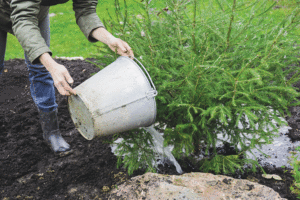
Allowing the soil to completely dry out will provide no moisture protection for the roots of your trees and shrubs when the ground freezes.
When forcing paper-white bulbs in soil, you need seven to nine weeks to allow them to come into bloom.
Choose bulbs that have not yet sprouted and plant them within four weeks after purchase.
If you have to wait before planting, store the bulbs in a dry warm room about 60 degrees F.
Plant the bulbs in bulb pans, setting the bulbs up to their shoulders in gritty potting mix, and then adding enough gravel to cover the necks.
Soak the soil in the pots, and allowing the water to drain. Set the pots in room temperatures of 45-60 degrees and water sparingly, about once a week until the growth begins.
If you like the look of these beautiful flowers, but not the fragrance, you can now purchase unscented varieties of paper-whites.
Hyacinths can be forced in water and hyacinth glass vases.
Remember, when purchasing these bulbs, look for ones “pre-chilled.”
Simply fill the vase with water to just touch the bottom of the bulb, and place the bulb on the top.
You get two shows, the flowers at the top and the roots in the water.
Amaryllis bulbs need well-drained, gritty soil and to be planted in good, heavy pots, since the blooms are large and can make the pot top-heavy.
Plant the bulb with the top third showing above the soil line.
Water the pots thoroughly and place them in a warm room.
Maintain moderate moisture, not allowing the bulb to dry-out or set in water, and fertilize each time you water.
They should come into bloom in about five or six weeks at normal home conditions.
The flower stalk will rise first, then the foliage.
The flowers can last up to two weeks, and if you have a larger bulb, you may get more than one or two flower stalks.
WEEKLY GARDENING TIPS
WEEK ONE
• Do not rotate your holiday cactus when watering as you do with other indoor tropical plants. Doing this after the flower buds have set will cause the buds to bend toward the light, thus severing and causing them to drop off. If you water in the sink, simply draw a line on the pot which is closest to the window and place back in the same location, in the same position.
• For all evergreens, camellias, rhododendron, azaleas, viburnum, and even roses, consider using Wilt-Pruf. This product will seal in the moisture and help protect the plant from winter’s bitter drying winds, and protect the crown of newly planted shrubs when freezing and thawing cycles occur. One application will be enough for the winter season.
WEEK TWO
• If you have sandy loam soils in your vegetable garden (such as those in Caroline and northern Dorchester counties), consider adding fresh cow or horse manure. This will allow enough time for the manure to decompose and be ready for spring to provide the much needed organic matter for your garden.
• Before the first anticipated hard freeze be sure to water all your trees and shrubs, including bulbs and perennial beds. As these drought conditions continue you will need to provide at least an inch of rain per week, remember: if the sky doesn’t provide the rain you need to water!
Allowing the soil to completely dry out will provide no moisture protection for the roots of your trees and shrubs when the ground freezes.
Remember just because the air temperatures are cooler, the ground temperatures will sometimes remain warmer longer. Watering is a must.
WEEK THREE
• If you haven’t done so, clean up iris beds, cutting back the stalks to the ground and removing all debris. This is important, since the iris borer may have laid its eggs in the stalks of the iris. Having cleaned the bed and removed the debris will eliminate the chances of having iris borers next May.
• Once your perennial and annual beds are all cleaned up, keep checking on them to make sure any dandelions and any other weeds have taken root. They are easy to spot now and are easy to pull up and dispose of before they are allowed to grow.
WEEK FOUR
• Fertilize your bramble fruits now, including raspberries and blackberries. Use a fertilizer high in organics which will feed now and jump-start the spring growing season. We recommend Plant-tone by Espoma.
• It is not too late to transplant any tree or shrub in your landscape. Sometimes things are planted too close to the house or they just simply outgrow the allotted area. Since the plants have gone dormant, it is more likely they will come through the transplanting well. Be sure to use Wilt-pruf for all evergreens to seal in the moisture, and apply Espoma’s Bio-tone when planting to prevent the plant from going into transplant shock, and provide much needed microbes for good root development.
(Editor’s Note: Ken Morgan is owner of Robin’s Nest Floral and Garden Center in Easton, Md.)



